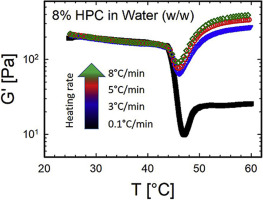Polymer ( IF 4.1 ) Pub Date : 2017-11-02 , DOI: 10.1016/j.polymer.2017.10.066 Salvatore Costanzo , Rossana Pasquino , Roberto Donato , Nino Grizzuti

|
We report on the inverse thermogelation of aqueous solutions of high molecular weight HydroxyPropylCellulose (HPC). The gelation process is investigated at different polymer concentrations, in the range 4÷16% (w/w). For each concentration, different heating rates are considered, in order to explore the effects on the sol-gel transition. Our findings corroborate the scenario proposed in literature for the thermoreversible gelation of cellulose derivatives, according to which the sol-gel transition is governed by an interplay of liquid-liquid phase separation and gelation. Gelation occurs in the polymer-rich phase via enhanced hydrophobic interactions between polymer chains at high temperature. At low heating rates, the phase separation proceeds significantly before the gelation occurs, creating more coarsened phases. As a consequence, the polymer network is less percolated and results in a weaker gel. Such an effect is more evident in less concentrated solutions characterized by a shorter terminal relaxation time, that is, faster polymer diffusion. As HPC concentration and heating rates are increased, the dissipative capacity of the final gel, expressed by the value of the phase angle at high temperatures, becomes nearly independent on polymer concentration and heating rate. However, the absolute values of the viscoelastic moduli of the formed gel increase with both HPC concentration and heating rate. The temperature window where transition occurs slightly narrows down with increasing concentration.
中文翻译:

聚合物浓度和热历史对羟丙基纤维素水溶液逆热凝胶化的影响
我们报告了高分子量羟丙基纤维素(HPC)水溶液的逆热凝胶化。研究了在4÷16%(w / w)范围内的不同聚合物浓度下的胶凝过程。对于每种浓度,考虑不同的加热速率,以探索对溶胶-凝胶转变的影响。我们的发现证实了文献中提出的纤维素衍生物热可逆凝胶化的方案,根据该方案,溶胶-凝胶转变受液-液相分离和凝胶化相互作用的支配。通过在高温下聚合物链之间增强的疏水相互作用,在富聚合物相中发生胶凝。在低加热速率下,相分离在发生胶凝之前显着进行,从而产生更多的粗化相。作为结果,聚合物网络的渗透较少,导致凝胶较弱。在以较短的末端弛豫时间为特征,即更快的聚合物扩散为特征的浓度较低的溶液中,这种效果更加明显。随着HPC浓度和加热速率的增加,最终凝胶的耗散能力(由高温下的相角值表示)变得几乎与聚合物浓度和加热速率无关。然而,所形成的凝胶的粘弹性模量的绝对值随HPC浓度和加热速率两者而增加。随着浓度的增加,发生转变的温度窗口会稍微缩小。更快的聚合物扩散。随着HPC浓度和加热速率的提高,最终凝胶的耗散能力(由高温下的相角值表示)变得几乎与聚合物浓度和加热速率无关。然而,所形成的凝胶的粘弹性模量的绝对值随HPC浓度和加热速率两者而增加。随着浓度的增加,发生转变的温度窗口会稍微缩小。更快的聚合物扩散。随着HPC浓度和加热速率的提高,最终凝胶的耗散能力(由高温下的相角值表示)变得几乎与聚合物浓度和加热速率无关。然而,所形成的凝胶的粘弹性模量的绝对值随HPC浓度和加热速率两者而增加。随着浓度的增加,发生转变的温度窗口会稍微缩小。所形成凝胶的粘弹性模量的绝对值随HPC浓度和加热速率的增加而增加。随着浓度的增加,发生转变的温度窗口会稍微缩小。所形成凝胶的粘弹性模量的绝对值随HPC浓度和加热速率的增加而增加。随着浓度的增加,发生转变的温度窗口会稍微缩小。











































 京公网安备 11010802027423号
京公网安备 11010802027423号